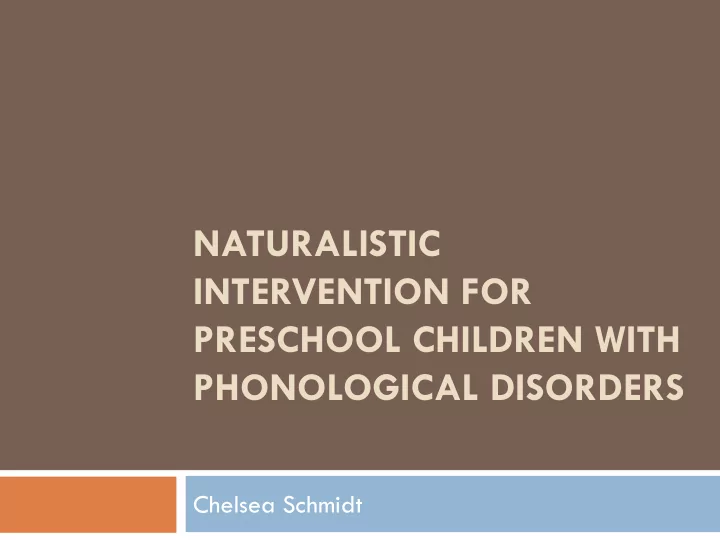

NATURALISTIC INTERVENTION FOR PRESCHOOL CHILDREN WITH PHONOLOGICAL DISORDERS Chelsea Schmidt
Background Information 3 year old Severe phonological disorder Multiple processes used: Final consonant deletion Stopping of fricatives and affricates Prevocalic voicing Velar fronting Cluster reduction Weak syllable deletion Idiosyncratic errors
Focused Clinical Question For a preschool-aged child with a severe phonological disorder, is a linguistic approach or a minimal pair approach more effective in improving intelligibility?
Inclusion Criteria Inclusion: Preschool aged children with phonological disorders 1-1 therapy Linguistic-approach Communication-centered Whole-language Broad-based Scaffolded-language Naturalistic Minimal pair approach Improved intelligibility Suppression of processes
Exclusion Criteria Exclusion: Studies of low evidence Different disorder: apraxia, articulation disorders etc. Non-English speaking or English as a second language
Search Strategy Databases: Academic Search Premiere CINAL ASHA Search Terms: Severe phonological disorder Improved intelligibility Whole-language approach Language-based therapy Suppressing final consonant deletion Play-based therapy Minimal pair approach Broad-based intervention/approach/therapy Treating phonological disorders Phonological disorder therapy
Search Results Studies Located: 172 Title/Abstract Review: 7 Articles Included: 3 Hoffman, P., Norris, J., Monjure, J. (1990). Comparison of process targeting and whole language treatments for phonologically delayed preschool children. Language, Speech, and Hearing Services in Schools, 21, 102-109. Hart, S., Gonzalez, L. (2009). The effectiveness of using communication-centered intervention to facilitate phonological learning in young children. Communication Disorders Quarterly, 32(1), 13-25. doi: 10.1177/1525740109333966. Bellon-Harn, M., Credeur-Pampolina, M., LeBoeuf, L. (2012). Scaffolded-language intervention: Speech production outcomes. Communication Disorders Quarterly. 34(2), 120-132. doi: 10.1177/1525740111425086.
Article Brief: Comparison of Process Targeting and Whole Language Treatments for Phonologically Delayed Preschool Children. Method: 2 boys aged 4;1 Moderate phonological disorders Minimal pair approach: Auditory discrimination Imitate in words, phrases, sentences, and conversation Whole-language approach: Listened to story Retell the story Clinician expansions and models after incorrect phonological productions Results: Both children improved intelligibility
Article Brief: The Effectiveness of Using Communication-Centered Intervention to Facilitate Phonological Learning in Young Children Method: 3 children ages 3;7-4;11 Severe phonological disorders Communication-centered approach: Storybook reading 2 activities that facilitated naturalistic interactions Feedback: Correct: Repeat and acoustically highlight target Incorrect: Minimal pair and opportunity to self-correct Results: Increased intelligibility in 2 children Maintained results in 1 child at follow-up
Article Brief: Scaffolded-Language Intervention: Speech Production Outcomes Method: 2 children 4;2 and 4;8 Phonological disorder Scaffolded-Language Intervention: Repeated Storybook Reading (RSR) Same book every session Read more pages each time Spontaneous responses or WH- questions to elicit responses Feedback: Correct: Expansions Incorrect: Minimal pair or imitation of target response Results: Improved intelligibility in both children
Summary/Key Findings Linguistic and minimal pair approaches were effective Used together to improve intelligibility
Limitations Lack of common vocabulary Small sample sizes Low levels of evidence Lack of recent studies
Clinical Bottom Line Both the linguistic and minimal pair approaches were effective Used together Naturalistic exchanges with minimal pairs as corrective feedback Further research is needed
Recommendations Further research should include: Larger sample sizes Higher levels of evidence Comparison of the combination of approaches to each approach separately
Recommend
More recommend